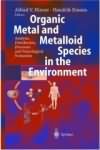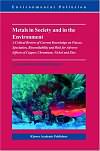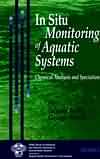The following list gives some details on books devoted to elemental speciation (analysis) published between 2001 and 2005. The list is neither exhaustive nor do we guarantee that all books are still available.
Handbook of Elemental Speciation, II: Species in the Environment, Food, Medicine and Occupational Health
Rita Cornelis (Editor),
Joe Caruso (Editor), Helen Crews (Editor),
Klaus G. Heumann
Wiley, 2005, 784 pages (ISBN: 0-470-85598-3)
Written by an internationally recognized group of editors and
contributors, Handbook of Elemental Speciation, Volume 2 provides a
comprehensive, cross-disciplinary presentation of the analytical
techniques involved in the speciation of key elements (arsenic, lead,
copper, iron, halogens, etc.) and addresses their
impact in food, the environment, clinical and occupational
health.
Handbook of Elemental Speciation: Techniques and Methodology
Rita Cornelis (Editor-in-Chief),
Joe Caruso (Associate Editor), Helen Crews (Associate Editor),
Klaus G. HeumannWiley, 2003, 670 pages (ISBN: 0-471-49214-0)
This
international collection of chapters comprehensively covers different
aspects of procedures for speciation analysis at all levels starting
from sample collection and storage, through sample preparation
approaches to render the species chromatographable, principles of
separation techniques used in speciation analysis, to the element
specific detection.
 Organic Metal and Metalloid Species in the EnvironmentAlfred V. Hirner
Organic Metal and Metalloid Species in the EnvironmentAlfred V. Hirner, H. Emons, Springer, 2004, 346 pages (ISBN: 3-540-20829-1)
Multidisciplinary articles written by experts from disciplines as diverse as biogeochemistry, ecotoxicology, analytical chemistry, microbiology and genetics estimate the global levels of biogeogenic and anthropogenic emissions of organometal(loid) compounds, and thus obtain an insight to processes which influence the genesis, as well as the distribution and stability of organometal(loid) species and their interaction with each other and other matrix compounds. The authors evaluate various environmentally relevant sources from a toxicological point of view, in order to identify potential "hot spots" of organometal(loid)s, which can negatively influence ecosystems and human health.

Metals in Society and in the Environment : A
Critical Review of Current Knowledge on Fluxes, Speciation,
Bioavailability and Risk for Adverse Effects of Copper, Chromium,
Nickel and Zinc
by Lars Landner, Rudolf Reuther
Kluwer, 2004, 407 pages (ISBN 1402027400 )
This book presents new results on metal fluxes from society to the
environment, on metal speciation in water, soil and sediment, and its
interpretation in terms of mobility, biological uptake and toxicity.
The scientific fundamentals of new approaches, like the Acid Volatile
Sulphide (AVS) concept to predict metal bioavailability in sediments,
and the Biotic Ligand Model (BLM) to calculate the toxicity of metals
to aquatic organisms, are critically evaluated, with a focus on copper,
nickel, zinc, and, in part, chromium.
Hyphenated Techniques in Speciation Analysis,
This book offers a brief but comprehensive overview of hyphenated
techniques and their various applications for the determination of
chemical forms of trace elements. It brings a succinct presentation of
the concept of speciation analysis, gives an overview of techniques
based on coupling of chromatography with element and molecule specific
detection and summarises their applications in the fields of
environmental and industrial chemistry, biochemistry, nutrition,
toxicology and medicine.
Bioavailability of Lanthanides to Freshwater Organisms: Speciation, Accumulation & Toxicity
by Lennart Weltje
Delft Univ Pr (December 1, 2002), 193 pages (ISBN: 9040723583)
The lanthanides comprise fifteen trivalent metals that belong to
the group of the rare earth elements. In the past decades, the number
of applications and industrial uses of lanthanides have increased, and
so did their emissions to the environment. Since a larger part of these
emissions ends up in freshwater ecosystems, insight is required into
the fate of lanthanides and their effects and their effects on
organisms. The research described in this thesis addresses this topic.
Trace Element Speciation for Environment, Food and Health
This book provides an insight into applied research in the
speciation field and how it has become so important in all the fields
represented. With its comprehensive coverage, it will be of particular
interest to researchers in industry and academia, as well as government
agencies and legislative bodies.
Chemical Speciation in the Environment, 2nd edition,
edited by A.M. Ure and C.M. Davidson
Blackwell Publishing, 2001, 480 pages (ISBN 063205848X)
In the second edition of this book, the expertise of scientists
involved in chemical speciation in various fields have been brought
together to provide an overview of the current status of speciation
science and indicate how the field may develop in the future. Following
a discussion on general strategies for speciation, the 14 chapters
focus on direct methods of metal speciation, hybrid methods of
speciation, predicting chemical speciation and computer simulation,
quality control in speciation studies for environmental monitoring and
the speciation of elements in the different compartments of the
environment.
 In Situ Monitoring of Aquatic Systems: Chemical Analysis and Speciation,
In Situ Monitoring of Aquatic Systems: Chemical Analysis and Speciation,
Jacques Buffle, George Horvai, John Wiley & Sons, 2001, 642 pages (ISBN: 0-471-48979-4)
This outstanding volume enables researchers to develop robust sensors and instruments for automatic 'on site' measurement of water quality. The need for an efficient multi-parameter monitoring system is ever- increasing, given that human activity is impacting so greatly on eco - systems and the increased need to develop our understanding of the underlying environmental processes.
Edited by two renowned experts, this book evaluates developments over the last 10-20 years which will form the basis of future sophisticated in situ monitoring systems. The emphasis is on micro-analytical monitoring techniques and microtechnology.
last time updated: June 17, 2018